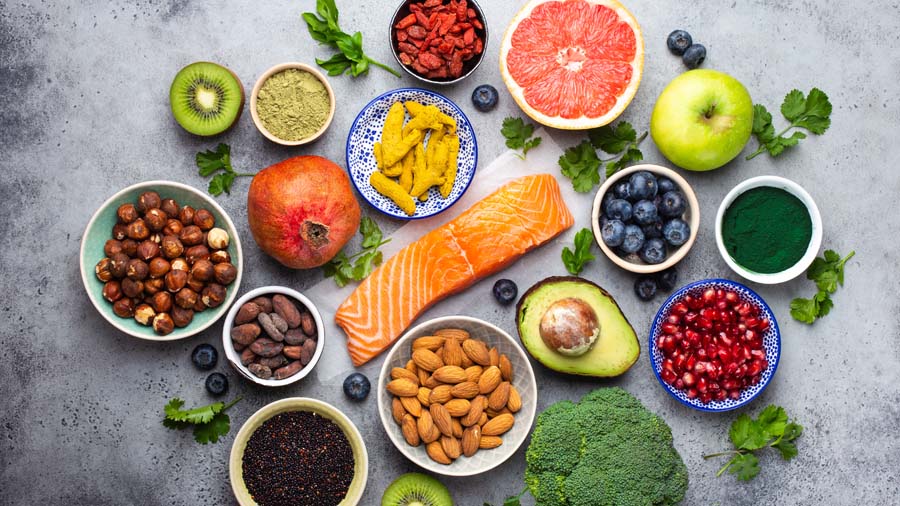Now Reading: Polyphenols: Nature’s Secret Weapon for Better Health
-
01
Polyphenols: Nature’s Secret Weapon for Better Health
Polyphenols: Nature’s Secret Weapon for Better Health

In the world of nutrition and wellness, we often hear about “superfoods,” antioxidants, and compounds that promise to protect our bodies from disease. But behind the colorful fruits, fragrant teas, rich spices, and even dark chocolate lies one of nature’s most powerful and overlooked health allies: polyphenols.
These naturally occurring plant compounds have been studied for decades, yet science continues to uncover their far-reaching effects—from reducing inflammation to supporting brain function. For anyone looking to live longer, feel better, and invest in long-term wellness, understanding polyphenols is a game changer.
What Are Polyphenols?
Polyphenols are a diverse group of plant-based micronutrients found in fruits, vegetables, herbs, teas, wines, coffees, and even legumes and nuts. Their name comes from their chemical structure—multiple phenol units—but what matters for everyday health is how they act as defenders of your body’s cells.
Think of polyphenols as the plants’ own protective armor. Plants produce them to ward off pests, resist disease, and cope with environmental stressors like UV rays. When we eat polyphenol-rich foods, we inherit that same protective armor—except instead of shielding leaves or roots, it shields our cells, tissues, and organs.
The Four Families of Polyphenols
Scientists group polyphenols into four major categories, each with unique health benefits:
- Flavonoids – The largest group, found in berries, citrus fruits, tea, onions, kale, and red wine. Known for strong antioxidant and anti-inflammatory properties.
- Phenolic acids – Found in coffee, whole grains, and certain fruits. Often linked to reduced risk of cardiovascular disease.
- Polyphenolic amides – Including capsaicinoids in chili peppers and avenanthramides in oats. These often influence metabolism and inflammation.
- Other polyphenols – Resveratrol (in red wine and grapes) and curcumin (in turmeric) are two well-known members.
Each category plays a slightly different role, but together they create a symphony of protection that strengthens nearly every system in the body.
How Polyphenols Work in the Body
At the cellular level, polyphenols are most famous for their antioxidant activity. This means they neutralize free radicals—unstable molecules that cause oxidative stress, a key factor in aging and chronic disease.
But that’s just the beginning. Polyphenols also:
- Reduce inflammation: They help calm the body’s immune response, preventing long-term damage linked to arthritis, heart disease, and metabolic syndrome.
- Support gut health: Polyphenols feed beneficial gut bacteria, acting like prebiotics. A healthy microbiome strengthens digestion, immunity, and even mental health.
- Improve blood vessel function: Certain polyphenols increase nitric oxide, which relaxes blood vessels, improves circulation, and lowers blood pressure.
- Protect the brain: Some polyphenols cross the blood-brain barrier, reducing inflammation in brain cells and protecting against cognitive decline.
In short, polyphenols act as multitaskers—targeting root causes of chronic conditions instead of masking symptoms.
Polyphenols and Heart Health
One of the most researched areas is cardiovascular health. Studies show that diets high in polyphenol-rich foods are linked to:
- Lower risk of hypertension
- Reduced LDL (“bad”) cholesterol oxidation
- Increased HDL (“good”) cholesterol
- Improved endothelial function (health of blood vessel lining)
For example, flavonoids in cocoa and dark chocolate have been shown to improve blood flow and reduce blood pressure. Similarly, resveratrol in red grapes and wine may help reduce arterial stiffness.
These benefits explain why the Mediterranean diet—rich in olive oil, nuts, wine, and produce—is consistently ranked among the healthiest eating patterns in the world.
Polyphenols and Brain Function
Your brain may benefit as much as your heart. Polyphenols are linked to better memory, sharper focus, and lower risk of neurodegenerative diseases like Alzheimer’s and Parkinson’s.
Berries are particularly powerful. Blueberries, strawberries, and blackberries contain anthocyanins that support signaling between brain cells and protect neurons from inflammation. Drinking green tea, rich in catechins, has also been associated with slower cognitive decline in older adults.
Polyphenols, Gut Health, and Immunity
Your gut microbiome—home to trillions of bacteria—thrives on polyphenols. These compounds act like fertilizer for good bacteria such as Bifidobacteria and Lactobacillus while helping suppress harmful strains.
A healthier microbiome leads to:
- Stronger immune defense
- More efficient digestion
- Reduced risk of obesity and diabetes
- Improved mood and mental health (thanks to the gut-brain connection)
Foods like apples, green tea, and pomegranates are particularly gut-friendly polyphenol sources.
Polyphenols and Cancer Prevention
Though research is ongoing, polyphenols show promise in reducing cancer risk. Their antioxidant, anti-inflammatory, and DNA-protective properties may slow the development of cancer cells and inhibit tumor growth.
For example:
- Green tea catechins have been studied for reducing breast and prostate cancer risk.
- Resveratrol may inhibit cancer cell proliferation.
- Curcumin shows anti-tumor activity in lab studies.
While polyphenols are not a cure, they may play an important role in prevention when combined with a healthy lifestyle.
Best Food Sources of Polyphenols
If you’re wondering how to get more polyphenols, the answer is delicious:
- Berries: Blueberries, blackberries, raspberries, strawberries
- Fruits: Apples, grapes, cherries, pears, plums, pomegranates, citrus fruits
- Vegetables: Spinach, kale, onions, artichokes, broccoli
- Beverages: Coffee, green tea, black tea, red wine (in moderation)
- Spices & Herbs: Turmeric, cloves, star anise, cinnamon, oregano, thyme
- Legumes & Nuts: Soybeans, black beans, peanuts, almonds, walnuts
- Dark Chocolate & Cocoa: High-cacao varieties pack a polyphenol punch
A simple tip: The richer the color of the plant, the higher the polyphenol content.
How to Maximize Polyphenol Intake
- Eat the rainbow. Choose deeply colored fruits and vegetables every day.
- Spice it up. Herbs and spices are concentrated sources—use them generously.
- Choose whole over processed. Processing often strips away polyphenols.
- Pair with healthy fats. Olive oil, avocado, and nuts improve absorption.
- Mix raw and cooked. Some polyphenols survive cooking, while others shine in raw form.
- Go moderate with wine and chocolate. These can be great sources—but balance matters.
Polyphenols and Everyday Living
The beauty of polyphenols is accessibility. You don’t need expensive supplements or exotic powders to benefit. You can start today with small, delicious choices:
- Add blueberries to your morning oatmeal.
- Sip green tea in the afternoon instead of soda.
- Season dinner with turmeric, oregano, or thyme.
- Swap milk chocolate for a square of dark chocolate.
- Enjoy a colorful salad drizzled with olive oil.
These tiny shifts compound over time, quietly reducing disease risk and supporting longevity.
What About Supplements?
Polyphenol supplements exist, but whole foods are usually the better choice. In food, polyphenols work synergistically with fiber, vitamins, and other compounds. Supplements can be helpful in specific cases but may not offer the same broad benefits—and sometimes doses are too high to be safe long-term.
For most people, aiming for 5–9 servings of fruits and vegetables daily, plus regular intake of legumes, nuts, herbs, and teas, will naturally deliver robust levels.
The Bottom Line
Polyphenols may not have the same buzzword status as protein, probiotics, or collagen, but they are silent heroes of health. They defend cells, calm inflammation, feed your microbiome, sharpen your brain, and support your heart—all while being abundant in everyday foods.
By leaning into a diet rich in polyphenols, you’re not just eating for the moment—you’re investing in resilience, longevity, and vitality. In a world filled with health fads and quick fixes, polyphenols remind us of a simple truth: nature has already equipped us with powerful tools for thriving.
So the next time you sip green tea, bite into a crisp apple, or savor dark chocolate, know that you’re not just indulging—you’re fueling your body with the protective power of polyphenols.



